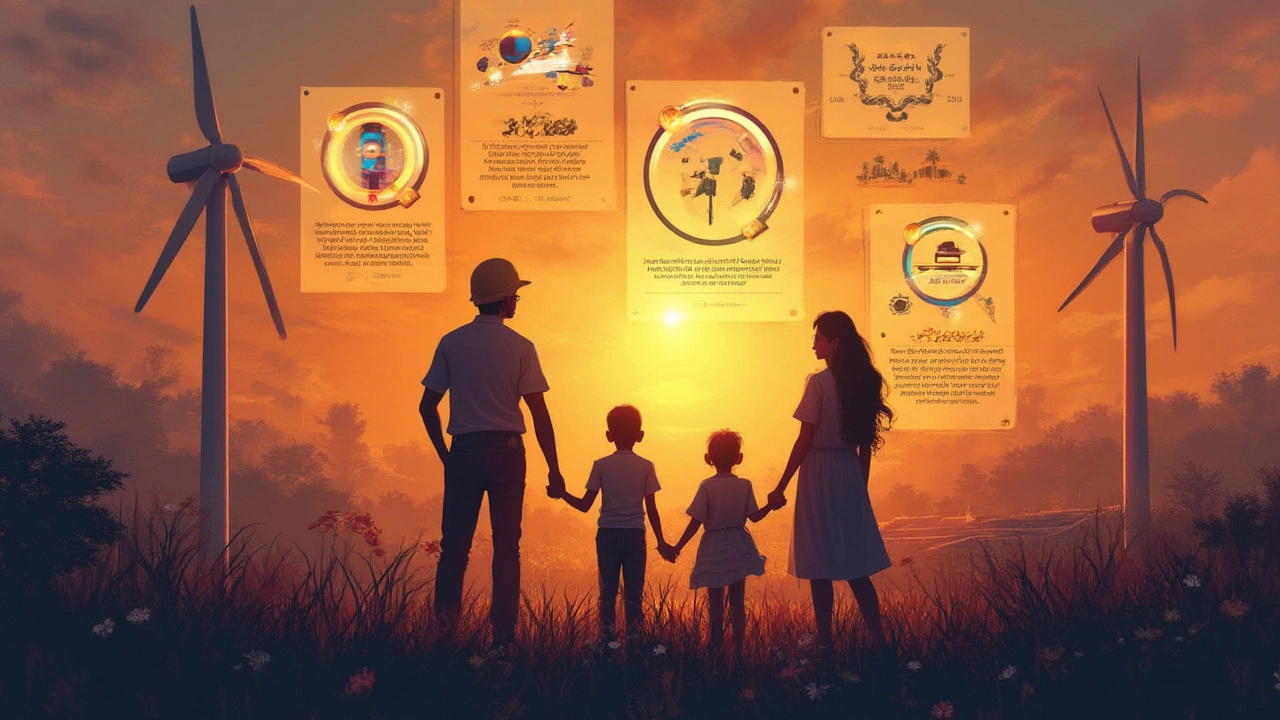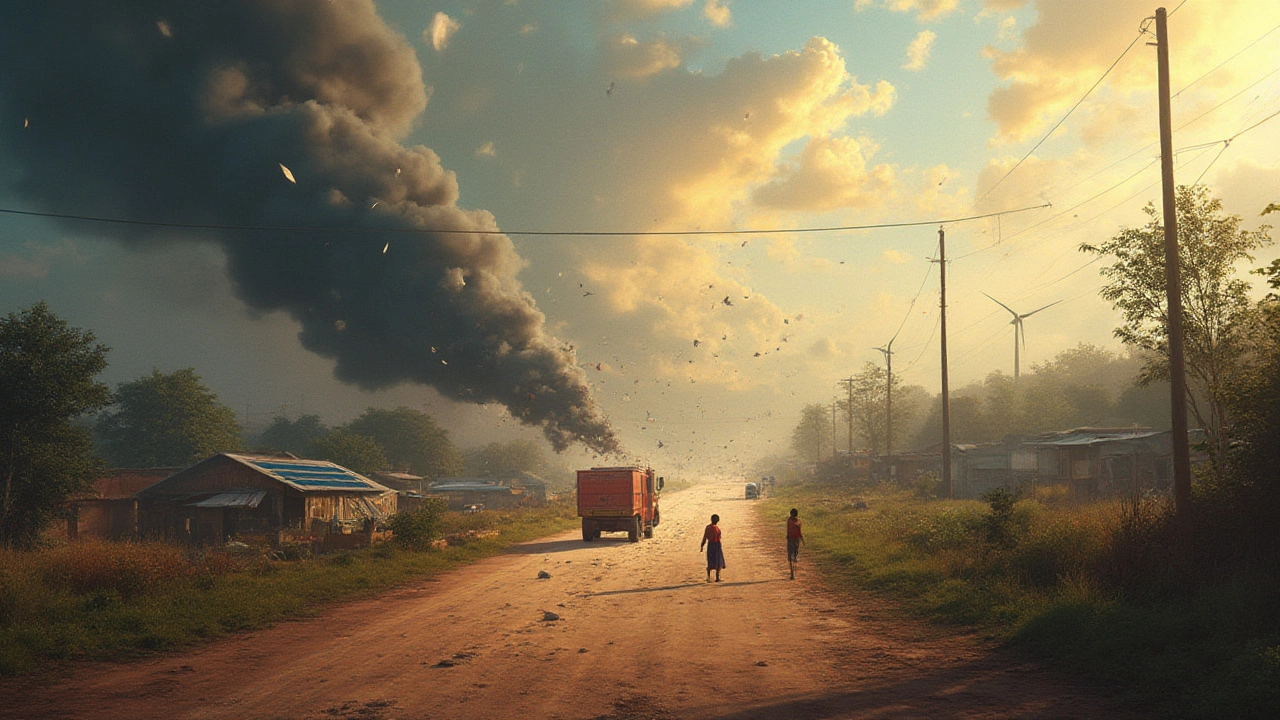Which Energy Source Causes the Least Human Deaths? Data and Real Stories
 Jul, 8 2025
Jul, 8 2025
Picture this: You flip on the lights when you get home, turn up the AC, scroll on your phone, and never think twice about it. Someone once said, “Electricity is like air. You only notice it when it’s gone.” But under the surface, all that energy comes at a cost—sometimes, the cost is human lives. What’s wild is how different the story is, depending on how that energy is made. Some energy sources sound scary (looking at you, nuclear), while others have a shiny, safe image (hello, solar panels). But do the facts match what we’ve been led to believe? Let’s pull back the curtain and see which energy source really involves the fewest deaths. Your assumptions might not survive the trip.
The Most and Least Deadly Sources: Surprising Numbers
First, here’s the million-dollar question: Which energy source actually kills the fewest people per unit of electricity produced? If you’re picturing nuclear meltdowns, you’re not alone. After all, movie disasters burn images into our brains. But when researchers crunched the numbers—including accidents, pollution, mining injuries, and even long-term health effects—some clear winners and losers emerged. To stack them up fairly, experts usually look at deaths per terawatt-hour (TWh) of energy produced. That helps even out differences in scale.
Check out this simple table for estimated deaths per TWh, based on recent studies and updates by Our World in Data as of 2023:
| Energy Source | Deaths per TWh (estimated avg.) |
|---|---|
| Coal | 24.6 |
| Oil | 18.4 |
| Biomass | 4.6 |
| Natural Gas | 2.8 |
| Hydropower | 1.3 |
| Wind | 0.04 |
| Solar (rooftop) | 0.02 |
| Nuclear | 0.03 |
Here’s the headline: energy source deaths are lowest for solar, wind, and nuclear. Fossil fuels—especially coal and oil—cause way more deaths, mostly through air pollution and mining accidents. In fact, burning coal for energy is easily the deadliest. Not something many people want to admit if they grew up near a coal plant, but it’s on paper. What’s maybe even more shocking? When you reader hear about huge disasters, like Chernobyl or Fukushima, the numbers seem massive. But even counting those, nuclear’s death rate per unit of energy is still lower than many people expect. For every billion kilowatt-hours, nuclear energy claims only a few lives—compared to thousands for coal.
Why is that? Fossil fuels don’t just kill through accidents. It’s the slow, invisible churn of pollution—tiny particles, bad air, and long-term lung disease. In cities where coal is king, like parts of India and China, researchers have tracked higher rates of everything from asthma to heart attacks. Even the number of traffic deaths from trucking coal or oil is counted in some reports. Add it all up, and the numbers are tough to ignore.
Digging Into the Details: Accidents, Pollution, and Hidden Dangers
It’s easy to look at a table and move on, but every number hides a real-life story. Accidents grab the front page, but the smaller, slow-burn impacts rarely make headlines. Let’s break it down.
Coal has killed millions, but not from the explosions, cave-ins, or those dark, unforgettable mine disasters. Most deaths are from plain old air pollution—sulfur, nitrogen oxides, and especially PM2.5, those microscopic particles that clog lungs and hearts. In 2019 alone, Harvard researchers linked air pollution from fossil fuels to over 8 million premature deaths globally. That’s about 1 in 5 deaths worldwide! Coal mining also has direct risks: deaths from collapsing mines in Appalachia, China, Siberia; black-lung disease taking workers in their 50s. The stories out of West Virginia aren’t much different from Shanxi, China.
Oil & Gas? Less dust and soot than coal, but the rigs and refineries aren’t exactly safe zones. Remember that Texas refinery explosion in 2005? Fifteen dead, hundreds injured. Offshore drilling’s notorious for “blowouts”—like the Deepwater Horizon explosion in 2010, which killed 11 and led to environmental chaos. Beyond big events, routine work accidents in the oil and gas patch quietly pile up, week after week. Add in the silent toll of illnesses from everyday exposure to fumes and leaks, and the invisibility cloak slips a little.
Hydropower seems like a gentle green giant, but don't forget the rare cataclysms. The Banqiao Dam failure in China (1975) claimed a staggering 171,000 lives—one of history’s worst human-made disasters. While those kinds of accidents are rare, they’re not impossible, especially where regulations are poor or corruption is high. Another downside: smaller hydro projects can mess up ecosystems, affect water supply, or trigger landslides, leading to indirect risks for communities.
Nuclear terrifies most people thanks to movies and Cold War nightmares. The reality is messier. Yes, accidents happen: Chernobyl in 1986 killed around 31 directly, but long-term radiation spikes led scientists to estimate several thousand more cancer deaths decades later. Fukushima in 2011 had no immediate radiation deaths, though over 1,000 people died in the evacuation chaos following the tsunami and disaster. Everyday operation? Ridiculously strict safety compared to anything in fossil fuel work. Radiation exposure for everyday operators is lower than a flight attendant’s average cosmic-ray load.
Solar and Wind might sound harmless, and most of the time they are. The biggest risks are surprisingly low-key: installers falling off roofs, high-voltage shocks during repairs, rare accidents at wind farms (think technicians working 100 meters up). The death rate here is tiny. What pushes it up slightly for solar is just the number of roof-based installations compared to big utility plants.

Cultural Fears vs. Reality: The Psychology of Safety
You ever notice how we’re terrified of some things but barely think about others, even if they’re deadlier? Nuclear energy burns up movie screens, but doesn’t get much real estate in our day-to-day worries. When you see solar panels, you don’t imagine a guy slipping off a roof. But a nuclear plant? Boom, instant disaster film. What gives?
This isn’t an accident. Psychologists call it “dread risk.” It’s why plane crashes haunt your mind more than car wrecks, even though you’re far likelier to die on the road. Energy is no different. Nuclear disasters are so dramatic, so out-there, that they stick with us—while the deadlier but slower threat of coal smoke, for example, is invisible and easy to downplay. News cycles feed this dread: an explosion at a refinery is a headline, but the millions dying quietly from dirty air or chronic exposure to carcinogens are just numbers in a statistic. The actual odds? Not even close. Wind and solar, which almost never hit the news for safety issues, actually sit at the bottom of the death-toll chart.
There’s also the “newness” factor. Technologies that feel unfamiliar freak people out more. When nuclear first arrived, public wasn’t told much, so it stayed mysterious and scary. Now, any accident gets magnified globally, even as day-to-day risks at plants remain incredibly low. Solar panels feel non-threatening because they look like something you’d put in your backyard, not a high-security government project. Familiarity matters in safety perception, even when the numbers disagree.
Going Deeper: Factoring In Climate Change and Long-Term Health
It might be tempting to just ask, "Who dies, and how many?" But only counting direct accidents tells half the story. What about indirect effects, like climate change? Turns out, the deadliest energy sources also dump out the most greenhouse gases. Coal, oil, and gas drive the climate crisis, which means more heat waves, wildfires, floods, crop failures, and health emergencies. Scientists at The Lancet linked extreme heat in Europe’s 2022 summer to more than 60,000 deaths. Worse weather from global warming isn’t directly pinned to energy plants, but the dots connect. Cleaner sources like wind, solar, and nuclear barely budge the climate needle—so their lifetime death toll is much lower in the long run.
One tip: ask how an energy source affects your city’s daily air. Cities switching from burning coal to solar or wind see asthma rates drop, hospital visits fall, and even life expectancy rise. For example, when Ontario phased out coal plants, its smog days went from dozens per year to literally zero. Residents started breathing easier—literally. Want your kids to grow up healthy? Advocate for cleaner energy in your community.
Still, it’s not a slam dunk. Some solar panel production involves toxic chemicals if not properly managed, and rare earth mining for wind turbines has its own problems—though way less scale than coal mining. Keep an eye on how ‘green’ your green energy really is. But for most people, it’s the invisible dangers—what you can’t see, smell, or feel—that are most overlooked.

Lessons From the Data: How to Lower the Risks Yourself
If you really want fewer energy source deaths, policy and personal action matter. Switching away from coal and oil toward wind, solar, and maybe even nuclear, is the most effective thing countries can do on a big scale. But there are small, real-world choices everyone can help make safer too:
- Support locally-owned renewable energy projects. Rooftop solar, community wind turbines…each project chips away at the global death toll.
- If you’re a homeowner or business owner, hire certified professionals for any solar or electrical work. Most solar deaths occur from falls or electrical mistakes—totally preventable.
- Push for stronger regulations protecting energy workers—whether that’s miners, plant operators, or maintenance techs. Safety gear and clear rules save thousands of lives.
- Ask your local and national reps about phasing out the dirtiest plants. Use health data—like years of life lost from air pollution—to show it’s not just a climate thing, it’s life-and-death for neighborhoods.
- Learn the full picture before jumping to conclusions. The safest energy system is the one you rarely notice—because it’s not making anyone sick or putting workers at unnecessary risk.
So, what’s the safest energy source in human terms? The data makes it clear: solar and wind are nearly tied at the bottom of the death charts, just a hair safer than nuclear if you look at worldwide numbers. Hydropower sits somewhere in between, but when huge dams fail, the consequences can be catastrophic. The real danger isn’t always where you expect it. Sometimes, the deadliest risks are the ones you can’t see…or haven’t been told about. Next time someone sparks up the old wind vs. nuclear debate, just hit them with the real numbers—then see how fast the conversation changes.